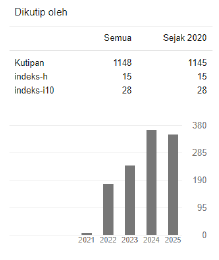Kant’s Aesthetic Essentiality as Exposed on Selena Gomez’s Who Says
 https://doi.org/10.54012/jcell.v3i3.253
https://doi.org/10.54012/jcell.v3i3.253
 Abstract views: 292
Abstract views: 292
 PDF downloads: 325
PDF downloads: 325
Keywords:
Aesthetic Essentiality, Immanuel Kant, Selena Gomez, Who Says, Women’s BeautyAbstract
Beauty for women is crucial as an intersection of their desires, needs, and satisfactions. Who Says is a song by Selena Gomez released in 2011 that inspires women to be confident since beauty is actually essential. Immanuel Kant’s aesthetic essentiality underlines that beauty is not agreeable since it relies on its own essence. Then, how may Kant’s aesthetic essentiality see the position of beauty in Selena Gomez’s Who Says? Through qualitative method on cultural studies, this article exposes Kant’s perspective and Gomez’s song. Recent various beauty standards make women feel insecure, but the song encourages girls to be who they are and not let what other people say get to them. All women should ignore forceful beauty standards because any expectation could be detrimental to women’s self-esteem. In conclusion, the song shows that beauty is essential and could only be experienced by individuals, not by any beauty standard.
Downloads
References
Allison, H. E. (2001). Kant’s Theory of Taste: A Reading of the Critique of Aesthetic Judgment. Cambridge University Press.
Attamimi, F. N., Smarandreetha, F. G., & Pasopati, R. U. (2023). Idealized Female Beauty as Represented in Alessia Cara’s Song Scars to Your Beautiful. Alungcipta Jurnal Ilmiah Multidisiplin, 1(3), 110–117.
Aulia, A. D., Annasai, A. A., & Pasopati, R. U. (2022). The Implementation of Conspicuous Consumption on Gender as Indicated on Jax’s Victoria’s Secret. Proceedings of International Seminar Enrichment of Career by Knowledge of Language and Literature, 42–55.
Berger, D. (2009). Kant’s Aesthetic Theory: The Beautiful and Agreeable. Continuum Publishing. https://doi.org/10.5840/intstudphil199325338
Chang, J. (2015). A Society’s Perception of Beauty. www.rhshightimes.com/a-societys-perception-of-beauty
Drees, M. T. (2021). Aesthetic Experience and Moral Vision in Plato, Kant, and Murdoch. Palgrave Macmillan. https://doi.org/10.1007/978-3-030-79088-2
GeniusMedia. (2011). Who Says Lyrics. https://genius.com/Selena-gomez-and-the-scene-who-says-lyrics
Hamidah, G. F. A., Rengganis, D. A., Budianto, S., & Pasopati, R. U. (2023). Gynocriticism As Bolstered On Margaret Atwood’s Giving Birth. Jurnal Multidisiplin Dehasen, 2(2), 225–232.
Hayn-Leichsenring, G. U., & Chatterjee, A. (2019). Colliding Terminological Systems: Immanuel Kant and Contemporary Empirical Aesthetics. Empirical Studies of the Arts, 37(2), 6–15.
Heidemann, D. H. (2020). Response to my critics: In defense of Kant’s aesthetic non-conceptualism. Con-Textos Kantianos, 12, 173–190. https://doi.org/10.5281/zenodo.4304075
Hughes, F. (2007). Kant’s Aesthetic Epistemology: Form and World. Edinburgh University Press.
Hughes, F. (2010). Kant’s “Critique of Aesthetic Judgment”: A Reader’s Guide. Continuum Publishing.
Ibrahim, L. N., Calista, S. N., & Pasopati, R. U. (2022). Gender Dysphoria as Interpreted on Against Me!’s FUCKMYLIFE666. Proceedings of International Seminar Enrichment of Career by Knowledge of Language and Literature, 105–115.
Ibrahim, L. N., Calista, S. N., & Pasopati, R. U. (2023). The Relevance of God’s Voice in Conscience and Its Impact to Character Building. Proceeding International Conference on Religion, Science and Education, 349–355.
Kuplen, M. (2021). Reflective and Non-reflective Aesthetic Ideas in Kant’s Theory of Art. British Journal of Aesthetics, 61(1), 1–16. https://doi.org/10.1093/aesthj/ayaa035
Kuplen, M. (2023). Kant’s Aesthetic Cognitivism: On the Value of Art. Bloomsbury Publishing.
Lopes, D. M. (2021). Beyond the Pleasure Principle: A Kantian Aesthetics of Autonomy. Estetika: The European Journal of Aesthetics, 1(1), 3–6.
Maharaj, A. (2013). The Dialectics of Aesthetic Agency: Revaluating German Aesthetics from Kant to Adorno. Bloomsbury Publishing. https://www.academia.edu/download/59135685/Dialectics_intro.pdf
Millenia, P. A., Fitriani, N. A., Kartiningsih, R., & Pasopati, R. U. (2023). The Implementation of Irony of The Old Man as Indicated on Luigi Pirandello’s War. Jurnal Sosial Humaniora Dan Pendidikan, 2(1), 29–35.
Pasopati, R. U., Oktavia, D., Ayu, E. R., Salsabiyla, R., Andharu, D., (2023), The
Representations of Socialist Feminism on Lesley Gore’s You Don't Own Me, Anaphora: Journal of Language, Literary, and Cultural Studies, 6 (2), pp. 118-129.
Pujimahanani, C., Hasana, F. A., Rafiuddin, R., Pakerti, B. L., Pasopati, R. U., (2023), The Significance of Socially Constructed Behaviors to Modern Identities on Em Beihold’s "City of Angels", Anaphora: Journal of Language, Literary, and Cultural Studies, 6 (2), pp. 159-174.
Sarmi, N. N., Kirana, K. S., Wijaya, K., & Pasopati, R. U. (2023). Authenticity and Its Discontent as Reflected on Heinrich Böll’s The Laugher. LET: Linguistics, Literature and English Teaching Journal, 13(1), 68–84.
Sasa, M. S. (2019). An Appraisal of the Concept of Beauty in Immanuel Kant’s Philosophy. GNOSI: An Interdisciplinary Journal of Human Theory and Praxis, 2(2), 5–9.
Schulting, D. (2016). Kantian Nonconceptualism. Palgrave Macmillan.
Sethi, J. (2019). Two Feelings in the Beautiful: Kant on the Structure of Judgement of Beauty. Philosophers’ Imprint, 19(34), 4–5.
Smarandreetha, F. G., Attamimi, F. N., Wijaya, K., & Pasopati, R. U. (2023). The Representations of Inferiority Complex as Depicted on Virginia Woolf’s’ The Duchess and The Jeweller’. Jurnal Adijaya Multidisiplin, 1(1), 240–247.
Sontag, S. (1975). A Woman’s Beauty. wheelersburg.net/Downloads/Sontag.pdf
Wenzel, C. H. (2009). Kant’s Aesthetics: Overview and Recent Literature. Philosophy Compass, 4(3), 3–11.
Wijaya, T. I., Ibrahim, L. N., Pujimahanani, C., & Pasopati, R. U. (2023). The Idea of Constructive Feminism in Naguib Mahfouz’s The Answer is No. KOLONI, 2(1), 122–131.
Downloads
Published
How to Cite
Issue
Section
License
Copyright (c) 2024 Rommel Utungga Pasopati, Erlis Hersetya Firda, Evangelin Rambu Ayu, Muhammad Abu Rijal Fahmi, Raddine Salsabiyla

This work is licensed under a Creative Commons Attribution-ShareAlike 4.0 International License.
All articles published in the Journal Corner of Education, Linguistics, and Literature are licensed under the Creative Commons Attribution-ShareAlike License (CC BY-SA).

















